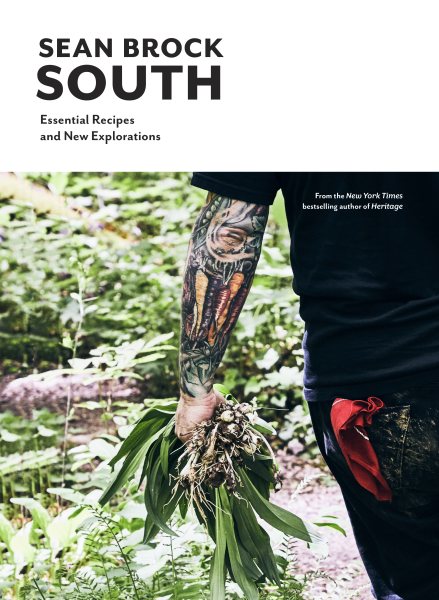By Lelia W. Salisbury. Special to the Clarion-Ledger Sunday print edition (January 5)
 Sean Brock, award-winning chef at the iconic Charleston, South Carolina, restaurant Husk, seems to find himself at a turning point. Like many Southerners, he is deeply aware of the concept and complexities of place.
Sean Brock, award-winning chef at the iconic Charleston, South Carolina, restaurant Husk, seems to find himself at a turning point. Like many Southerners, he is deeply aware of the concept and complexities of place.
As a chef, he has immersed himself in these Southern roots and let seasonal produce and local suppliers guide what ended up on the plate. He sees these food traditions as extending beyond the South, however. He argues that they are also part of a larger national story, and that what we cook and how we source are evolving right alongside our cultural landscape.
If Brock’s previous bestselling cookbook Heritage is a map to his cooking past, his new book, South, finds Brock laying the foundation for new directions in his own life and cooking. Recently relocated to Nashville and in the process of opening two new restaurants–his first solo ventures–Brock lays out his experience with the iconic food of the South and looks ahead.
For Brock, food not only reflects a way of life, but also serves as a balm for life in an ever-changing world. “Food is medicine, after all–it can heal the soul, help mend a broken heart, or calm a busy mind,” Brock writes in the introduction.
The recipes and the chef’s notes on ingredients and techniques reveal a man who takes a meditative approach to cooking, who sinks himself fully into the process and tools and sensory experiences of making delicious and nourishing food.
South is not a book to hurry through, either in the reading or in the cooking. Many of the recipes require lengthy resting or soaking times, so these are not dishes that will be ready quickly after a frenzied day at work. Instead, they are recipes that celebrate fresh, flavorful ingredients and honors the ways, both old and new, that they can be prepared.
The South is not a single, homogeneous region, and accordingly, Brock approaches the recipes in his book as reflections of the many micro-regions within the U.S. His own personal history reflects deep attachments to two very different parts of the South. He was born in the Appalachian region of Virginia, and he spent the formative part of his culinary career in the South Carolina low country.
Accordingly, he includes five recipes for cornbread, arguing that how one cooks cornbread is the result of both location and personal preference (not to mention that the grain itself will vary according to its origin and growing conditions). After explaining the importance of starting with a hot cast-iron skillet, beginning the cooking on the stove-top to create the all-important crust, Brock then lays out recipes for basic cornbread (no sugar for him) and variations of cracklin’ (a staple at Husk), sour, rice, and hot water cornbreads (the latter he calls the “skillet baked cousin” of traditional cornbread.
While fresh produce is at the heart of the book (Brock has a special fondness for ramps, a North American wild onion), he also writes extensively about grains. Heritage grains have played a starring role in Southern and local food movements of the past 20 years, and many of the recipes explore the Southern landscape through the grains of a particular region.
He reveals that a pressure cooker is his preferred away to cook grits at home (“Think of it like using a rice cooker to cook rice,” he writes). Hominy sits alongside preparations for Carolina Gold rice, Appalachian Fry Bread, and Southern food hero John Edgerton’s Beaten Biscuits (a non-leavened biscuit that has long been a staple of the regional holiday or funeral table).
Much has been written about the global South and ways that the cuisines of other countries inform Southern cooking. Brock understands these influences, but lets them manifest in marvelously subtle ways. Rather than bringing in non-regional ingredients, he honors these outside flavors by incorporating local ingredients of the same taste profile. Benne seeds, brought to the U.S. by West Indian slaves in the early 1700s, flavor Brock’s baby back ribs, add a Southern twist to Caesar dressing, and stand in for tahini in his Sea Island Red Pea Spread.
The “Pantry” section of the cookbook features both boiled peanut and hominy miso recipes. Brock explains that German immigrant to Appalachia made sour corn to satisfy their cravings for fermented foods, making them with what was locally plentiful. He incorporate this sour corn into several recipes, including a traditional chowchow, and he suggests it as an accompaniment for Hominy and Pokeweed Griddle Cakes or Fried Green Tomatoes.
South is a marvelous walk through the many souths and the dishes that define them. Brock shares new techniques for old favorites and includes a wide selection of recipes for staple sauces and sides, canned and pickled goods. He connects deeply with the techniques of cooking with and over fire, and he offers detailed explanations for how these types of cooking add flavor and can be done at home (he even includes a recipe for Hickory-Smoked Ice Cream).
At the heart of his cooking is a reverence for what he calls “natural flavors.” Brock’s recipes are designed to let the core ingredients shine, whether it is the potlikker that becomes the star of a sea bass recipe, or the pawpaw and banana pudding recipe that adds a local spin to a beloved southern classic.
Leila Salisbury is the former director of the University Press of Mississippi. She lives in Lexington, Kentucky.
Signed first editions of Sean Brock’s South are available in store at Lemuria and on our website.


Comments are closed.